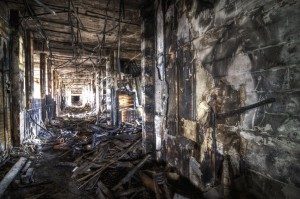
Structural engineering forensic investigations involve the investigation of structural failures to determine the cause of the failure, while considering factors such as design, construction, maintenance, and operation. They also involve analyzing and evaluating the evidence at hand to identify the most likely cause of failure in a building, bridge, or other structural system. Structural engineering forensic investigations typically occur after premature signs of distress (i.e., cracking, excessive deflections, excessive settlement), after damage by outside/environmental factors (i.e., storm damage, vehicle impacts, corrosion) or after the catastrophic failure of a structure.
Structural engineers are often called upon to examine structures that have experienced a failure, such as a building collapse or bridge failure. The goal of the investigation is to determine the cause of the failure so that corrective actions can be taken to prevent similar failures in the future. To do this, structural engineers use their expertise in structural design, construction, maintenance, and operations to analyze the structure’s components and identify any weaknesses that may have contributed to the failure.
During a structural engineering forensic investigation, engineers analyze the evidence at hand such as photographs, drawings, or physical specimens to determine what happened. Engineers may also use simulations to recreate the events leading up to the failure. This helps them to understand how a particular component or system functioned in the past and how its failure occurred.
Additional tests and laboratory analysis may be conducted on materials recovered from the site of the failure. These tests provide detailed information about the composition and condition of the material at various points in time. This allows engineers to make conclusions about the cause of the failure and assess its impact on overall structural performance.
In some cases, engineers may conduct post-event inspections of surviving structural components. This involves taking measurements, inspecting materials, and using various tests to determine the condition of the components. This helps the engineers to evaluate the existing structure’s ability to withstand future loads and helps them develop recommendations for reinforcing the structure if necessary.
In some cases, engineers may also analyze computer models of the structure to determine its behavior under different conditions. This allows engineers to make comparisons between the theoretical performance of the structure and its actual performance, which can help them identify potential weaknesses within the structure and make suggestions for improvements.
Structural engineering forensic investigations provide essential information for determining the cause of structural failures. By conducting detailed examinations of structural components, computer models, and physical evidence, structural engineers can accurately determine the root cause of a failure and suggest the best way to prevent future failures from occurring. These investigations are essential for improving the safety and reliability of our built environment.

